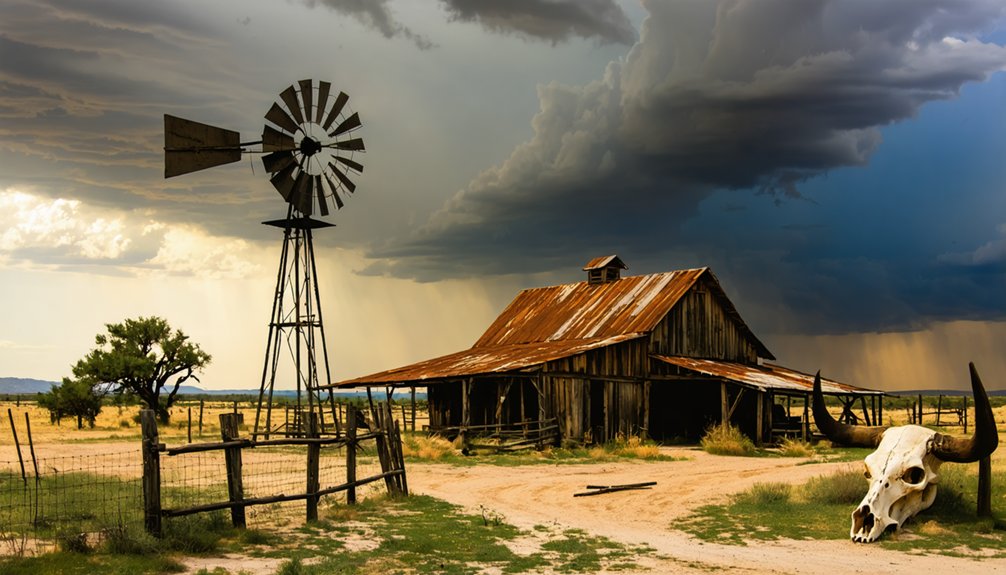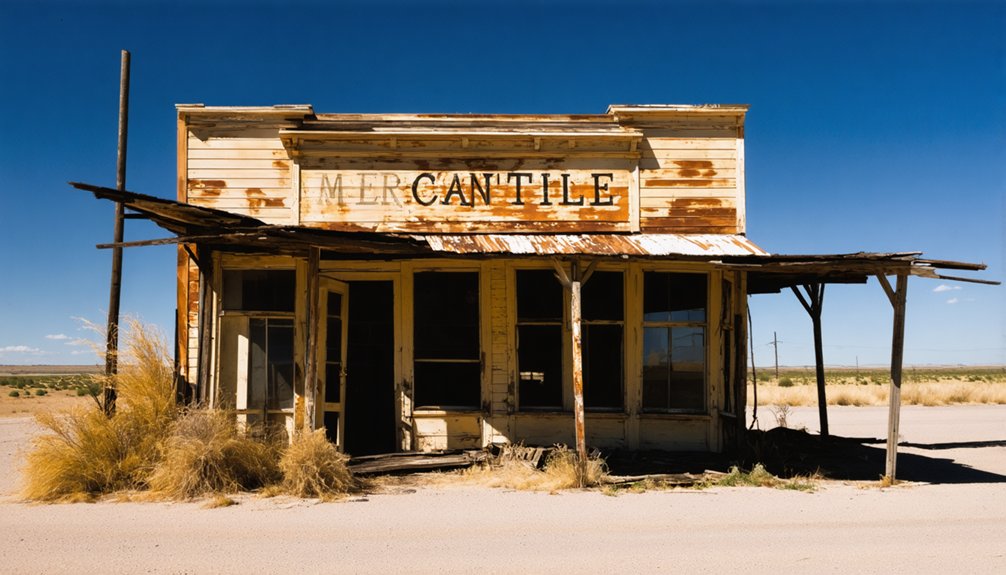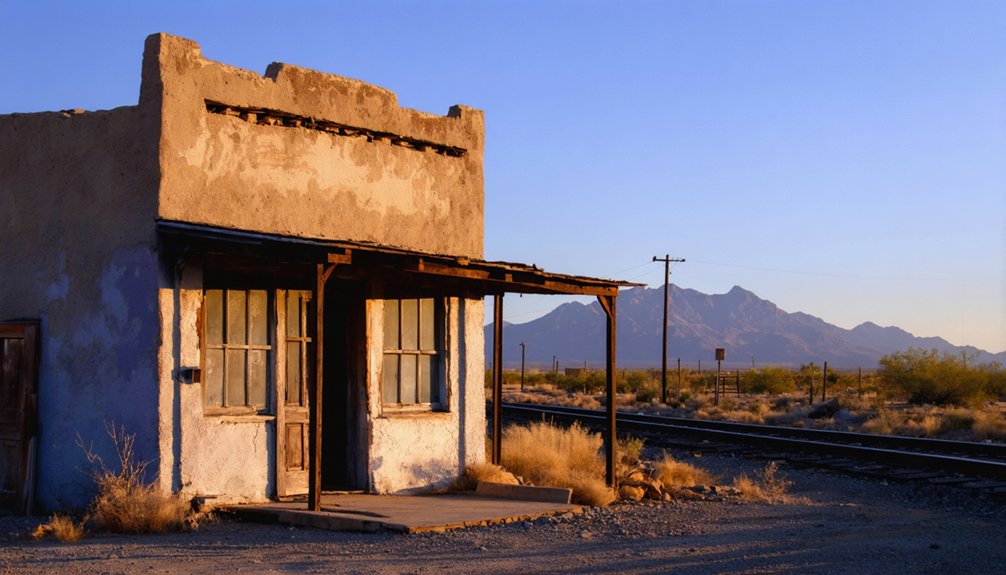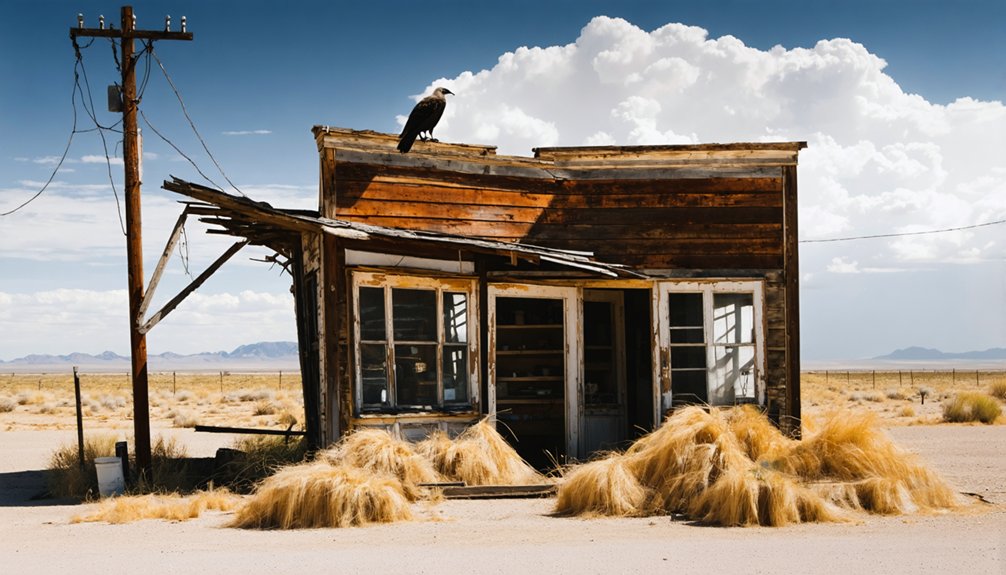You’ll find Kent, Texas, along the old Texas & Pacific Railway line in West Texas, where red sandstone ruins tell the story of a once-thriving ranching community. Originally named Antelope in 1892, the town grew to 50 residents by 1924, supported by cattle operations and a general store. While Interstate 10’s construction contributed to Kent’s decline, its architectural remnants and connection to the Reynolds brothers’ 250,000-acre ranching empire offer fascinating glimpses into frontier life.
Key Takeaways
- Kent began as Antelope in 1892 before being renamed, growing to 50 residents by 1924 as a ranching community.
- The town’s economy centered around cattle ranching, with the Reynolds family owning 232,000 acres of surrounding ranchland.
- Notable structures include the 1894 Old Kent County Jail made of red sandstone, now preserved as a historical site.
- Kent’s decline began in the 1960s, marked by the closure of its public school and reduced railroad traffic.
- The construction of Interstate 10 further isolated the community, contributing to its eventual transformation into a ghost town.
The Birth of a Desert Settlement
While pronghorn antelope once roamed freely across West Texas, they’d eventually inspire the original name of a small settlement that would later become Kent.
You’ll find this frontier outpost’s roots stretching back before 1892, when settlers recognized the strategic value of its location along the Texas & Pacific Railway line. Despite the harsh desert environment, pioneers carved out a living through agriculture and ranching, making the most of the railroad’s essential shipping capabilities.
The settlement quickly established itself as a significant supply hub for the region’s growing ranching operations. By 1893, you’d have found John Charles Rickli running the newly established post office, while two cattle enterprises dominated the local economy by 1896, setting the foundation for what would become a resilient desert community. Like many other settlers who faced the challenges of frontier life, most residents lived in primitive mud and straw huts during the early years of settlement. The town remained relatively small but stable throughout its early decades, maintaining a population of 50 to 65 residents from the 1920s through the 1960s.
From Antelope to Kent: A Name’s Evolution
You’ll find the earliest name of this Texas settlement derived from the abundant pronghorn antelope that once roamed its arid landscape before 1892.
The community’s identity transformed when John Charles Rickli became the first postmaster of the newly established Kent post office in 1893, officially changing the town’s name from Antelope to Kent.
This shift from a wildlife-based name to an administrative designation marked the area’s evolution from a natural habitat into a more structured settlement, though the pronghorn’s legacy remained deeply connected to the region’s heritage. Much like the historic Celtic origins of Kent in Britain, the name change represented a significant turning point in the area’s development. By 1914, the growing community supported four cattle breeders and a general store.
Early Settlement Naming Origins
Before becoming known as Kent, this West Texas settlement began its life in the early 1890s as Antelope, a name that reflected the area’s native wildlife and ranching heritage.
The naming conventions of the time often drew from the natural environment, particularly in areas where ranching dominated the local economy. You’ll find this pattern throughout West Texas settlements of the era, where communities initially adopted names tied to local wildlife or agricultural activities. The county’s 878 square miles of rolling terrain provided ideal conditions for ranching operations.
When the settlement established its first post office in 1892, it operated briefly under the Antelope name.
The historical significance of the community’s eventual change to Kent in 1893 marked its evolution from an informal ranching outpost to a recognized town along the Texas & Pacific Railway line.
Community Identity Transformation
As Kent’s identity evolved from its origins as Antelope in the early 1890s, the settlement underwent a significant transformation that reflected broader changes across West Texas communities.
You’ll find that the shift from a wildlife-based name to “Kent” marked more than just a postal designation – it represented the community’s cultural heritage and aspirations for permanence.
The change coincided with significant developments in the area’s community evolution. By 1896, cattle ranching operations had established a strong presence, and the population grew steadily to 50 residents by 1924.
The new identity helped Kent become a transportation hub where major roads intersected with the Missouri Pacific Railroad, cementing its role in regional commerce and communication networks beyond its frontier roots. Like the ancient Antelope Creek people, the settlement was strategically positioned along watercourses for survival and growth.
Post Office Establishes Kent
The establishment of Kent’s post office in 1892 marked a defining moment in the town’s evolution from Antelope to its modern identity. When John Brownrigg became the first postmaster on April 11, 1892, you’d have witnessed the town’s shift from its frontier origins to a more structured community hub.
Though the postal service briefly ceased in June 1892, it reopened under John Charles Rickli’s leadership in 1893.
This transformation from Antelope to Kent wasn’t just a simple name change. The new designation positioned the town within the Texas & Pacific Railway‘s growing network, reflecting its emerging role as a ranching supply center.
The post office became essential to Kent’s development, facilitating communication and shipping for the area’s flourishing livestock operations through the early 1900s.
Life in Early 20th Century Kent
Life in early 20th century Kent revolved around a close-knit ranching community, where cattle breeding and horse operations dominated the local economy. You’d find yourself among just 25 neighbors in 1914, though the population gradually grew to about 50 by 1924. Like other areas named Kent, this location required clear geographic distinctions to avoid confusion with similarly named places.
The ranching lifestyle centered on six local businesses, including several cattle operations and the X Ranch, known for its involvement in the racehorse industry. Your daily activities would’ve focused around the general store, which served as both a trading post and social hub. The area’s prosperity was supported by the Double Mountain salt works, which provided essential salt supplies during the Civil War era.
Despite the town’s small size, the community dynamics remained strong through shared agricultural pursuits. You’d rely on basic services from the post office and general store, while building connections through the tight-knit ranching networks that defined Kent’s character.
The Reynolds Brothers’ Ranching Legacy

You’ll find the Reynolds brothers’ lasting impact on Kent through their massive 232,000-acre Long X Ranch, established in 1895 in Jeff Davis County.
Their cattle operations, formalized as the Reynolds Cattle Company in 1884, expanded well beyond Texas into states like Montana and North Dakota, where they secured the first registered brand.
The brothers’ extensive ranching empire brought significant economic development to the Kent region, with their legacy living on through preserved structures like the 1897 barn and 1888 rock house. The brothers initially built their ranching foundation near Fort Griffin, Texas, where they began their successful cattle operation. Barber and Anne Marie Reynolds’ sons showed remarkable resilience in building their empire, having grown up in an area where Indian attacks were common.
Vast Ranch Land Holdings
Pioneering ranchers George Thomas and William David Reynolds established one of Texas’s largest ranching empires when they acquired 232,000 acres in Jeff Davis County in 1895.
The Long X Ranch served as their primary base for extensive ranching practices that would eventually span multiple states.
You’ll find their land management strategies reflected in holdings that grew to 250,000 acres across Texas counties including Haskell, Shackelford, and Throckmorton.
The Reynolds brothers didn’t stop at Texas borders – they expanded their operations into New Mexico, Arizona, Montana, and North Dakota.
Their cattle herds roamed freely from Texas to Canada, with the distinctive Long X brand marking their livestock across the frontier.
This vast network of ranches required strategic planning to manage operations across diverse terrains and climates.
Family’s Regional Economic Impact
Through strategic expansion and innovative cattle management, the Reynolds brothers transformed the economic landscape of the American West, starting with their 1895 acquisition of the Long X Ranch in Kent.
Their ranching innovations included pioneering post-Civil War cattle drives and establishing the first registered cattle brand in North Dakota.
You’ll find their economic resilience reflected in how they built a multi-state operation that connected Texas markets to northern territories, while adapting to frontier challenges.
- Created employment networks across multiple states through ranching operations
- Established essential infrastructure including stockades and security frameworks
- Developed systematic brand recognition spanning Texas to the Dakotas
- Fostered agricultural service ecosystems including transport and banking sectors
Architecture and Notable Structures
While Kent’s architectural legacy has largely faded into ruins, several notable structures still stand as evidence of the town’s former liveliness.
You’ll find the 1894 Old Kent County Jail, constructed of locally quarried red sandstone, standing as the town’s most significant example of ruin preservation. This robust structure, with its welded-shut cells, showcases the architectural significance of early Texas law enforcement buildings.
On the south side of the Interstate, you’ll spot Kent Public School‘s stone remains and a substantial rock ruin near the freeway offramp.
The town’s building style relied heavily on locally sourced materials, particularly red sandstone and cut rock.
North of the Interstate, you’ll discover more recent ruins, while strategically placed water tanks on nearby hills remind you of the town’s once-functioning infrastructure.
The Slow Fade Into Abandonment

Unlike many Texas ghost towns that vanished suddenly due to economic crashes or natural disasters, Kent’s path to abandonment unfolded gradually over several decades.
Kent’s slow fade into ghost town status stands in stark contrast to the abrupt abandonment typical of other Texas communities.
You’ll find the signs of community resilience tested through demographic shifts, as the population held steady at 50-65 residents until the 1960s before dwindling. The closure of Kent Public School in 1961 marked a significant turning point, fragmenting local ties and discouraging new families from settling.
- The Missouri Pacific Railroad’s presence couldn’t generate enough economic momentum to sustain growth.
- Interstate 10’s construction physically divided the town, altering traffic patterns.
- Local businesses like cafés and gas stations slowly disappeared as ranching declined.
Exploring Kent’s Remaining Buildings
The skeletal remains of Kent’s buildings tell a compelling story of small-town Texas life frozen in time.
You’ll find the most striking ghostly remnants south of Interstate 20, where the Kent Public School’s cut rock ruins stand prominently near the freeway offramp. Nearby, a historic water tank structure crowns a low hill, surrounded by substantial stone ruins.
North of the highway, architectural decay defines the landscape.
You’ll encounter an abandoned Chevron station, the old post office, and scattered residential homes bearing the marks of time and vandalism. Bullet holes and graffiti scar many structures, while barred windows and compromised doorways make exploration challenging.
Despite their deterioration, these buildings offer glimpses into Kent’s once-vibrant community, with living spaces still recognizable beneath years of neglect.
Historical Preservation Efforts

Preserving Kent’s architectural heritage has become a focal point for the Texas Historical Commission (THC) and local stakeholders.
You’ll find preservation challenges in Kent ranging from harsh weather damage to vandalism, but community engagement through local historical commissions and volunteer groups helps protect these irreplaceable structures.
The THC’s 2022-2032 Statewide Historic Preservation Plan provides strategies for protecting rural ghost towns while balancing economic growth with cultural preservation.
- Legal protections and tax incentives encourage private owners to invest in historic property rehabilitation
- Local volunteers maintain records, conduct educational programs, and monitor sites for vandalism
- State grants and federal programs provide critical funding for stabilization and restoration projects
- Archaeological excavations document Kent’s cultural artifacts while modern preservation techniques help stabilize remaining structures
A Photographer’s Paradise: Capturing Kent Today
Nestled beneath a West Texas highway in Culberson County, Kent’s abandoned structures and weathered ruins create an atmospheric canvas for photographers seeking authentic ghost town imagery.
You’ll find rich opportunities for urban exploration among the derelict gas station, post office, and school ruins, where peeling paint and rust tell silent stories through your lens.
Whether you’re shooting wide-angle landscapes or macro details, Kent’s isolation offers uninterrupted creative freedom.
Try various photographic techniques: capture star trails during clear nights, experiment with HDR to balance harsh desert light, or use long exposures during golden hour.
You’ll get the best results at sunrise or sunset when warm light bathes the weathered textures.
Just remember to pack essential gear and water – you’re in raw Texas territory where preparation matters as much as artistic vision.
Frequently Asked Questions
Are There Any Reported Ghost Sightings or Paranormal Activity in Kent?
Don’t get your hopes up – there’s no record of ghost encounters in this neck of the woods. While visitors sense an eerie vibe, paranormal investigations haven’t turned up any concrete evidence.
What Happened to the Original Residents and Their Descendants?
You’ll find most original residents scattered to nearby Texas towns, with their descendants maintaining informal ties to the area. Some family stories, especially from the Boyd family, preserve Kent’s ranching heritage.
Is It Legal to Visit and Explore Kent Today?
You can visit Kent, but must follow legal regulations and visitor guidelines. While there’s no explicit ban, you’ll need to verify property ownership and obtain permissions to avoid trespassing charges.
Were There Any Notable Crimes or Wild West Incidents in Kent?
You won’t find documented outlaw legends or gunfight history in Kent. While its old sandstone jail housed cattle thieves and moonshiners, the town itself lacks specific recorded wild west incidents.
Does Kent Still Maintain Any Working Utilities or Emergency Services?
Like a fading radio signal, you won’t find reliable utility infrastructure here. There’s no local emergency response – you’ll need to rely on distant Culberson County services for help if needed.
References
- http://freepages.rootsweb.com/~gtusa/history/usa/tx/kent.htm
- https://en.wikipedia.org/wiki/List_of_ghost_towns_in_Texas
- https://www.youtube.com/watch?v=MlKZaOsk6T4
- http://www.ghosttownaz.info/kent-texas.php
- https://www.texasescapes.com/TexasTowns/Luzon-Texas.htm
- https://www.ghosttowns.com/states/tx/kent.html
- https://www.texasescapes.com/WestTexasTowns/KentTexas/KentTexas.htm
- https://www.tshaonline.org/handbook/entries/colony-of-kent
- https://en.wikipedia.org/wiki/Kent
- https://www.tshaonline.org/handbook/entries/kent-county



